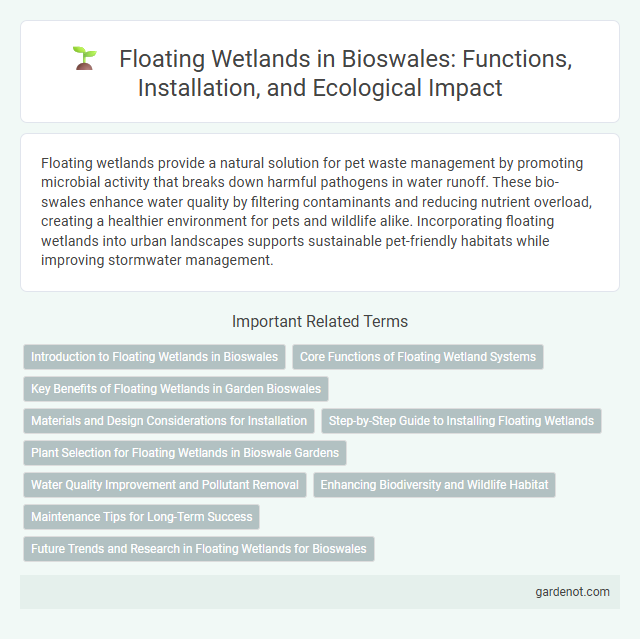Floating wetlands provide a natural solution for pet waste management by promoting microbial activity that breaks down harmful pathogens in water runoff. These bio-swales enhance water quality by filtering contaminants and reducing nutrient overload, creating a healthier environment for pets and wildlife alike. Incorporating floating wetlands into urban landscapes supports sustainable pet-friendly habitats while improving stormwater management.
Introduction to Floating Wetlands in Bioswales
Floating wetlands enhance bioswales by providing a dynamic surface for planting native aquatic vegetation, which improves water filtration and reduces pollutants. These wetlands increase biodiversity and promote habitat for beneficial wildlife, contributing to healthier urban water ecosystems. Integrating floating wetlands into bioswales optimizes stormwater management through natural processes that promote nutrient uptake and sediment capture.
Core Functions of Floating Wetland Systems
Floating wetland systems enhance water quality by facilitating nutrient uptake and sediment stabilization through their root structures. These systems provide critical habitat for aquatic organisms and support biodiversity by creating microenvironments within water bodies. They promote pollutant removal via microbial activity associated with plant roots, contributing to ecological balance and water purification.
Key Benefits of Floating Wetlands in Garden Bioswales
Floating wetlands in garden bioswales enhance water quality by filtering pollutants such as nitrogen, phosphorus, and heavy metals through natural plant uptake and microbial processes. These systems increase habitat diversity by providing refuge for beneficial insects, amphibians, and aquatic organisms, promoting ecological balance in urban landscapes. They also improve stormwater management by reducing runoff volume and slowing water flow, which mitigates erosion and enhances groundwater recharge.
Materials and Design Considerations for Installation
Floating wetlands utilize buoyant materials such as recycled plastic pontoons or polystyrene foam to support vegetation mats, ensuring stability and longevity in aquatic environments. Design considerations emphasize root zone depth, plant species selection, and nutrient uptake efficiency to maximize pollutant removal while maintaining structural integrity. Installation requires secure anchoring systems to prevent displacement, alongside modular designs for ease of deployment and maintenance in stormwater management settings.
Step-by-Step Guide to Installing Floating Wetlands
Installing floating wetlands begins with site selection, prioritizing areas with adequate sunlight and minimal wave action to support plant growth and stability. Secure a durable floating platform, typically made from recycled plastics or foam, and anchor it using weights or cables tailored to local water depth and flow conditions. Finally, plant native wetland species into the substrate mats on the platform, ensuring root systems can extend into the water to enhance nutrient uptake and provide habitat benefits.
Plant Selection for Floating Wetlands in Bioswale Gardens
Selecting native aquatic plants such as pickerelweed (Pontederia cordata), water lilies (Nymphaea spp.), and sedges (Carex spp.) optimizes nutrient uptake and supports local biodiversity in floating wetlands within bioswale gardens. Plants with extensive root systems enhance pollutant filtration and provide habitat for beneficial microbes, improving water quality and ecosystem resilience. Incorporating species adapted to fluctuating water levels ensures plant survival and maximizes the environmental benefits of floating wetland installations.
Water Quality Improvement and Pollutant Removal
Floating wetlands enhance water quality by providing a natural filtration system that removes pollutants such as nitrogen, phosphorus, and heavy metals. The plant roots in floating wetlands absorb and break down contaminants, promoting nutrient cycling and reducing harmful algal blooms. These bio-swales support aquatic biodiversity while effectively improving overall water clarity and ecosystem health.
Enhancing Biodiversity and Wildlife Habitat
Floating wetlands serve as innovative bio-swales, significantly enhancing biodiversity by providing critical habitats for aquatic and terrestrial species. These engineered ecosystems support a diverse range of flora and fauna, including migratory birds, fish, and beneficial insects, contributing to improved ecological balance. Their root systems also promote water quality by filtering pollutants and increasing oxygenation, thereby fostering healthier wildlife habitats.
Maintenance Tips for Long-Term Success
Regular inspection and removal of debris are critical for maintaining floating wetlands to ensure optimal water flow and plant health. Replacing dead or diseased plants promptly supports continued nutrient uptake and prevents invasive species proliferation. Monitoring water quality parameters such as pH, dissolved oxygen, and nutrient levels helps sustain a balanced ecosystem within the bio-swale.
Future Trends and Research in Floating Wetlands for Bioswales
Emerging research in floating wetlands for bioswales highlights advancements in nutrient uptake efficiency and pollutant filtration through engineered plant species and substrate materials. Integration of smart sensors enables real-time monitoring of water quality and bioswale performance, optimizing maintenance and ecological benefits. Future trends prioritize scalable modular designs that enhance urban stormwater management and support biodiversity while minimizing carbon footprints.
Floating wetland Infographic

 gardenot.com
gardenot.com